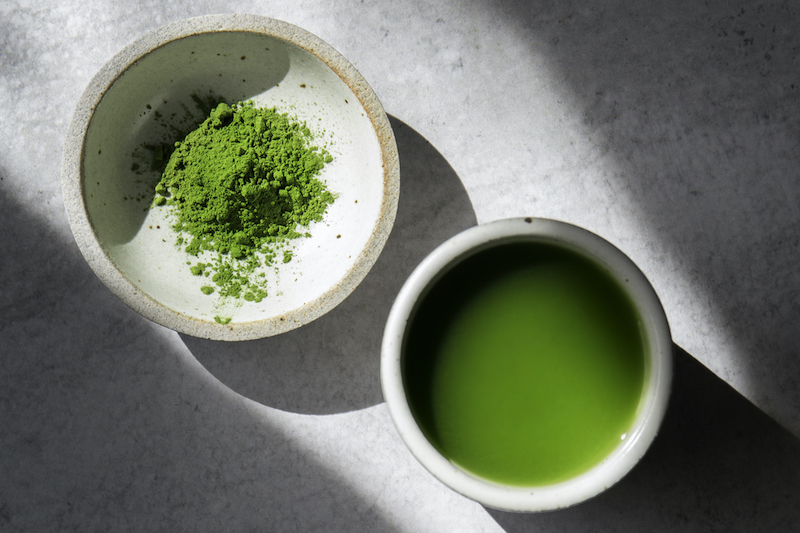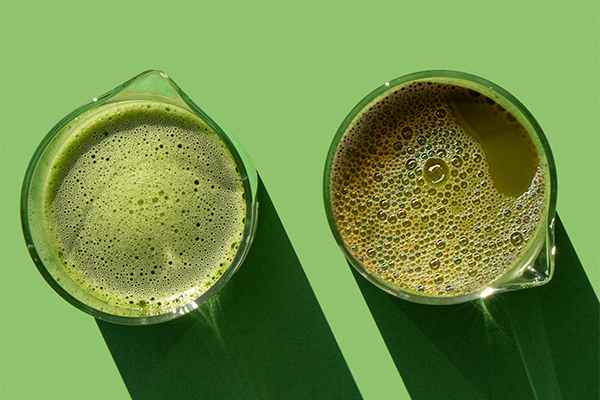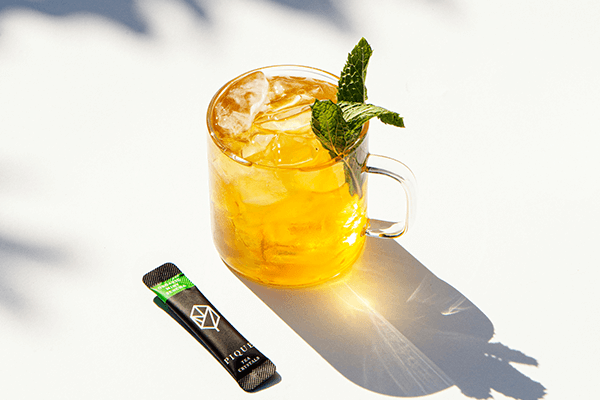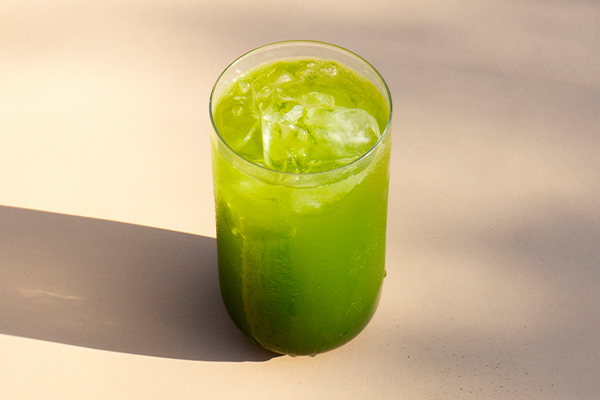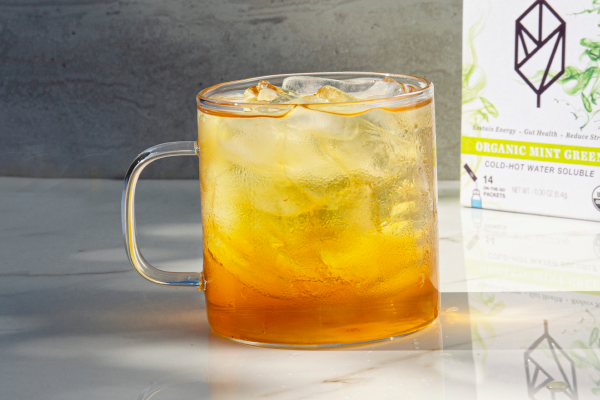Matcha tea is a trendy and delicious beverage all over the world, and for good reason!
It has a smooth, earthy flavor and it also gives you a nice buzz of energy (without the jitters and subsequent crash that sometimes comes with coffee).
Matcha tea has a stronger flavor than your standard brewed green tea since it’s made from whole, stone-ground green tea leaves (which you ingest when you drink it). You’ll also recognize pure matcha by its vibrant green color.
The good news is now that matcha is so popular, it’s easy to find. However, not all matcha powders are created equal, which is why it can be a challenge to find a quality product that also tastes good.
Keep reading to find out more about the origin and benefits of matcha, what to look for when choosing a quality product, and how to prepare and enjoy it.
What is matcha tea?
Matcha tea is made from grinding whole green tea leaves into a fine powder. The matcha green tea powder is then dissolved in hot water and prepared for drinking. Since you’re drinking the entire tea leaf, the flavor of matcha green tea is much stronger than your standard steeped tea.
Traditionally, matcha green tea is prepared by using a special whisk and a tea bowl.
This process of whisking the matcha tea powder with whisk and bowl is part of the traditional Japanese matcha tea ceremony. And while many people still use the same tools and methods from Japanese tea ceremonies, it’s not necessary for making and preparing matcha tea.
Even though matcha green tea’s popularity has exploded in recent years, it has been around for quite some time, with deep roots in Japanese culture.
In fact, matcha is a traditional green tea that people have enjoyed for thousands of years. Zen monks, in particular, have used matcha for its health benefits and energizing yet calming properties.
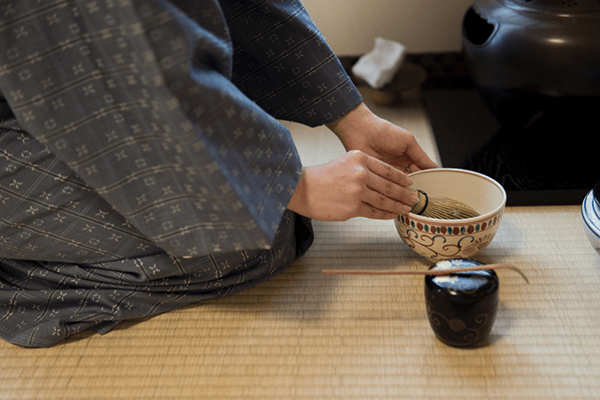
What is the difference between matcha and green tea?
When folks think about green tea, they generally think of tea leaves in a tea bag that you steep in hot water.
The difference between matcha green tea and standard green tea starts with the way the green tea leaves are harvested.
The matcha process starts when the green tea leaves are still growing. The plants are shaded before harvesting which results in a higher concentration of chlorophyll, giving the leaves a bright green color.
When the leaves are harvested, steamed, dried and blended, they are ground into a very fine powder.
Because of this, when you drink matcha green tea, you’re actually drinking the entire leaf compared to standard steeped tea where you’re drinking the elements that have dissolved from the leaves. This means that you’re getting more of the health benefits!
Matcha tea is delicious and also chock full of healthy benefits
Similarly to green tea, matcha green tea is known for its support in helping manage cravings as well as its antioxidant profile.
Matcha green tea contains high levels of a variety of beneficial ingredients including catechins, which studies have shown may help support cellular and metabolic health. Matcha is also high in good-for-you plant antioxidants called polyphenols. (2)
Many people who want to kick their coffee habit find success with swapping it out for matcha green tea. Why? Matcha green tea contains some caffeine (about 50 mg per teaspoon, which is about half of what a regular cup of coffee contains), but also includes L-theanine, an amino acid shown to help promote calmness and relaxation.
Combine the calming effect of the L-theanine with the focus-enhancing effects of caffeine, and you’ll find that you find that matcha green tea provides all the same energy-boosting and alertness benefits of coffee without the jitters. (3)
Matcha green tea’s high concentration of chlorophyll is also known to support the body’s natural detoxification process. In fact, chlorophyll is what also gives matcha its intense green color. (4)
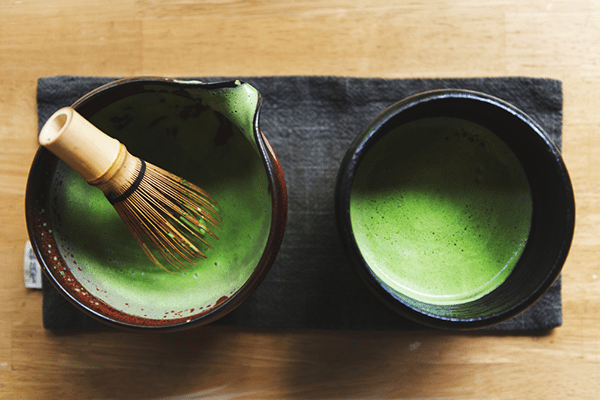
How to find the best matcha tea
Finding matcha tea isn’t the hard part – matcha is relatively commonplace and easy to obtain nowadays. Rather, the hard part is trying to decipher what makes the best matcha tea the best, and which factors you should really care about when looking for the best matcha tea.
We’ll cover some characteristics of matcha tea and how they impact the taste, quality, health benefits, and more.
Which “grade” is it?
When shopping for matcha tea, you will find two different types of matcha powder: ceremonial grade and culinary grade.
Ceremonial grade matcha tea
Ceremonial grade is considered the highest quality available on the market.
Ceremonial grade matcha should be bright green in color (given that it’s stored properly and contains high amounts of chlorophyll) and the texture is very fine.
Ceremonial grade matcha should not taste bitter but have the signature rich, umami flavor that you can only find in a good quality matcha powder. If your matcha powder is dull in color or very bitter tasting, that’s a sign that the particular product is lacking in quality.
Ceremonial matcha is delicious by itself in a hot cup of matcha, but it can also be enjoyed in a smoothie or a matcha latte.
Here’s our recommendation for the best ceremonial grade matcha:
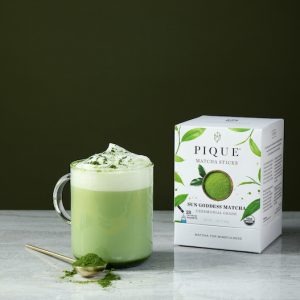
Pique Sun Goddess Matcha
The world’s purest matcha, crafted to the highest standards of the finest ceremonial grade matcha. Designed for mindfulness. A mug full of zen.
Culinary grade matcha tea
Culinary matcha powder is meant specifically for use in food, like in desserts or other baked goods.
It is typically less expensive since it’s intended for use in food, not drinking. The flavor profile is not as good as ceremonial grade since you want a different flavor result when baking or cooking with matcha.
It’s important to keep in mind that the matcha industry is not very regulated, so if you find a matcha product that is labeled anything other than “ceremonial grade,” it is most likely a culinary grade matcha.
There are five subgrades of culinary grade matcha tea, as well (5):
- Premium: Premium is the highest quality of the culinary grade matcha teas. It works well with blended drinks and your everyday matcha tea.
- Cafe: Cafe grade tends to be used in baking and cooking. It’s got a strong, robust flavor.
- Ingredient: Ingredient grade is mixed with older tea leaves, giving it a stronger flavor and a thicker consistency.
- Kitchen: Kitchen grade isn’t as fine as other matcha powders, is a darker green, and is quite bitter in flavor.
- Classic: Classic grade might be the most commonly available grade. It has a strong flavor and can be used with many foods, drinks, and smoothies.
Organic vs. conventionally grown
If you want to avoid pesticides and herbicides in your matcha tea, then an organic matcha green tea powder is your best choice.
Most matcha green tea farms in Japan are not organic farms, so if you’re looking for a high-quality matcha product that is also good for your health, you will want to look for an organic seal on the packaging.
If you want to ensure that you’re buying organic matcha green tea, you can check with the manufacturer to find out if they have any toxic screening processes for the product before it goes on the shelves or is shipped out. Some toxins to look out for in your matcha include heavy metals, fluoride, pesticides, toxic mold, and radioactive isotopes.
What type of “cultivar” is your matcha?
Note: this section is going to get a little nerdy, so you can probably skip it and still have the ability to pick out the best matcha tea brand.
The tea leaves cultivated for matcha are mostly grown in two Japanese regions: Uji and Nishio.
There are different types of “cultivars,” which are cultivated varieties of the plant. For matcha tea, the main cultivars are Yutaka Midori, Samidori, Okumidori, Sayama Kaori, Kanaya Midori, Asatsuyu, and Zairai. (6)
Why use different cultivars? There are many reasons, some of which have to do with qualitative aspects of the tea-drinking experience, such as the flavor or the color of the product. Some reasons, however, simply have to do with the harvest schedules of different varieties.
While factors like being organic and ceremonial grade may be more important for the initial selection of matcha tea, you may find after many trials that you prefer one type of cultivar or another. So for the serious tea connoisseur, this may be something to make a note of when you’re tasting teas.
What to look for on a matcha tea label/package
“Ceremonial grade matcha”
As mentioned above, ceremonial grade is considered the highest quality tea. Also make sure it is labeled “matcha tea,” not powdered green tea or green tea. This means that the product is not from Japan and the quality is questionable.
“Shade-grown, shaded”
Real, quality matcha plants are shaded before they are harvested. This helps to increase the chlorophyll and amino acid content.
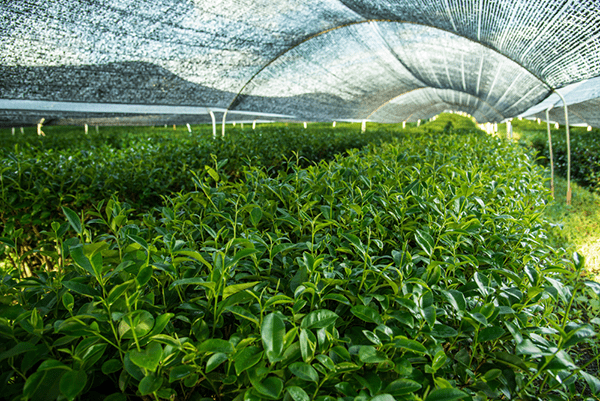
“Organic”
Organic matcha tea means that the product is free from harmful pesticides and herbicides that are often used by farms in the growing process.
“Toxin-Screened”
A toxin screening process ensures an even higher quality product since this often means that the matcha is third-party tested for toxins like heavy metals, fluoride, and mold.
How to make matcha tea (a quick guide)
Making matcha tea isn’t overly difficult, though there are a few different methods you can use. If you’d like to make it in the traditional way, which comes from Japanese matcha tea ceremonies, then you’ll need the following tools and equipment:
- Chasen or Bamboo Whisk
- Chawan or tea bowl
- Chashaku (bamboo scoop) or teaspoon
- Tea kettle, thermometer
While there are several ways to prepare matcha tea, if you want to try making it in the most traditional way, you can follow the steps below. (5)
- Scoop 2 chashaku’s of matcha into your tea bowl or chawan. (A Chashaku is about ¾ tsp).
- Add a bit of water (between 160-170 degrees F) to make a paste with the matcha powder.
- Add an additional 4-6oz of hot water and whisk matcha in an “M-shaped” motion until you get a layer of froth.
- Serve with honey, or your desired type of milk, sweetener or drink alone. You can also enjoy matcha over ice.
How to make a matcha green tea latte
If you’d like a creamier matcha tea, you can make matcha green tea lattes by preparing matcha as directed above and then adding 4-6oz of steamed nut milk (coconut milk in particular pairs well with matcha).
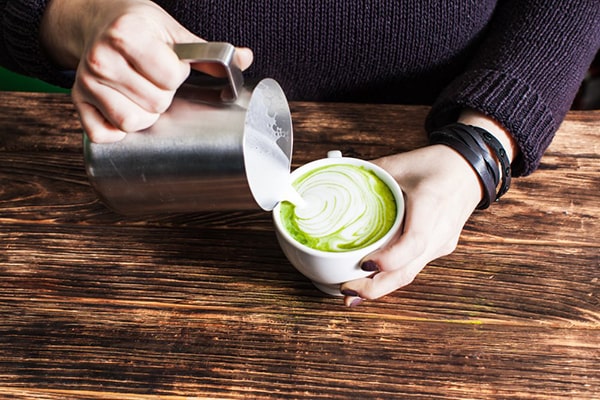
How to store matcha tea
Matcha tea is sensitive to heat, light, and humidity. So you’ll want to keep the powder in its original packaging (usually a sealed bag or a tin) in a cool, dark and dry place. If you don’t expect to use your matcha very often, you can even keep it in the refrigerator to extend the shelf life.
The Best Matcha Green Tea Brands
While there is certainly some subjectivity involved with picking the best matcha tea, we wanted to outline a few of the popular brands that fall in line with many of the above factors we’ve outlined (grade, organic, etc.). Here are the best matcha teas to buy:
1. Pique Tea
Pique Tea makes a matcha green tea that meets the world’s purest standards yet also delivers the same quality, potency and health benefits of the highest grade ceremonial grade matcha created by respected tea masters for formal tea ceremonies in Japan. You can mix Pique’s matcha tea with either hot or cold water for a quick but delicious matcha drink. Try it for yourself:

Pique Sun Goddess Matcha
The world’s purest matcha, crafted to the highest standards of the finest ceremonial grade matcha. Designed for mindfulness. A mug full of zen.
2. Encha
Encha is a popular organic matcha green tea powder. They have a farm in the Uji mountains of Kyoto, Japan, where they cultivate and sell ceremony grade matcha powder.
3. Matcha Bar
Matcha Bar is unique in that they make pre-bottled ceremonial grade iced matcha drinks. While you won’t get the traditional Japanese ceremonial aspects with these teas, you can find some really unique to-go products like their sparkling matcha “hustle” drink. Though they do, of course, sell tins of their own matcha tea powder as well.
4. Matcha Love
Matcha Love also makes and distributes pre-bottled matcha drinks, and they are fairly commonly seen at boutique grocery stores and coffee shops. They have tons of varieties, including unsweetened, flavored, and single-serving drinks. They also sell their matcha powder, though it is not advertised as ceremonial grade. Additionally, they sell culinary grade matcha powder for cooking purposes.
5. Mizuba Tea Company
Mizuba Tea Company offers an impressively wide variety of different matcha tea types of flavors, so you can try them and figure out the best matcha tea for yourself. They include high-quality ceremonial grade teas, all organic, and also daily matcha and even culinary grade matcha powder. For those looking for options, this place has many of them.
Other miscellaneous matcha tea powder makers include Jade Leaf matcha, Kenko, and Domatcha.
Final thoughts on choosing the best matcha
Once you know about the key factors that determine quality matcha, it’s not hard to find a product that suits your needs and tastes great.
Just by doing a bit of research and checking into the matcha quality beforehand will ensure you’re getting the best product for your money.
Matcha is a wonderful beverage that you can enjoy every day in place of coffee if you’re looking for something that helps you feel calm, alert, and energized.
It’s also a great beverage option to enjoy on occasion when you’re looking to switch things up from your regular go-to drink.
If you’ve yet to try the full-bodied, umami flavor of a good quality matcha tea, you’re in for a treat!
